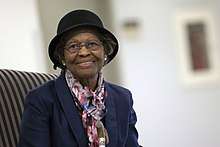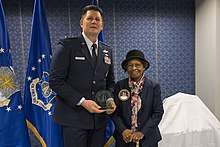Gladys West
Gladys Mae West (née Brown) (born 1930) is an American mathematician known for her contributions to the mathematical modeling of the shape of the Earth, and her work on the development of the satellite geodesy models that were eventually incorporated into the Global Positioning System (GPS).[1] West was inducted into the United States Air Force Hall of Fame in 2018.
Gladys West | |
|---|---|
 in 2018 | |
| Born | Gladys Mae Brown 1930 (age 89–90) |
| Nationality | American |
| Alma mater |
|
| Known for | Satellite geodesy |
| Spouse(s) | Ira West ( m. 1957) |
| Children | 3 |
Early life and education
West was born as Gladys Mae Brown in Sutherland, Virginia, in Dinwiddie County, a rural county south of Richmond.[1][2][3] Her family was an African-American farming family in a community of sharecroppers.[4] Her mother worked at a tobacco factory, and her father was a farmer who also worked for the railroad.[3] West realized early on that she did not want to work in the tobacco fields or factories like the rest of her family, and decided that education would be her way out.[5]
At West's high school, the top two students of each graduating class received full-ride scholarships to Virginia State College (now formally University), a historically black public university.[4] West worked hard and graduated in 1948 with the title of valedictorian.[3][5] She was initially unsure what college major to pursue at VSU, as she had excelled in all her subjects in high school. She was encouraged to major in science or math because of their difficulty, and West ultimately chose to study mathematics, a subject mostly studied at her college by men.[4] She also became a member of the Alpha Kappa Alpha sorority.[1] West graduated in 1952 with a Bachelor of Science in Mathematics.[3] After graduating, she taught math and science for two years in Waverly, Virginia.[3] West then returned to VSU to complete her Master of Mathematics degree, graduating in 1955.[5][3] Afterwards, she briefly took another teaching position in Martinsville, Virginia.[3]
Career

In 1956, West was hired to work at the Naval Proving Ground in Dahlgren, Virginia, (now called the Naval Surface Warfare Center), where she was the second black woman ever hired and one of only four black employees.[4][2][1] West was a programmer in the Naval Surface Warfare Center Dahlgren Division for large-scale computers and a project manager for data-processing systems used in the analysis of satellite data.[7] Concurrently, West earned a second master's degree in public administration from the University of Oklahoma.[3]
In the early 1960s, she participated in an award-winning astronomical study that proved the regularity of Pluto’s motion relative to Neptune.[8] Subsequently, West began to analyze data from satellites, putting together altimeter models of the Earth's shape. She became project manager for the Seasat radar altimetry project, the first satellite that could remotely sense oceans.[9][10] West consistently put in extra hours, cutting her team's processing time in half.[4] She was recommended for a commendation in 1979.[11]
From the mid-1970s through the 1980s, West programmed an IBM computer to deliver increasingly precise calculations to model the shape of the Earth – an ellipsoid with irregularities, known as the geoid. Generating an extremely accurate model required her to employ complex algorithms to account for variations in gravitational, tidal, and other forces that distort Earth's shape. West's data ultimately became the basis for the Global Positioning System (GPS).[8]
In 1986, West published Data Processing System Specifications for the Geosat Satellite Radar Altimeter, a 51-page technical report from The Naval Surface Weapons Center (NSWC). The guide was published to explain how to increase the accuracy of the estimation of geoid heights and vertical deflection, important components of satellite geodesy.[1] This was achieved by processing the data created from the radio altimeter on the Geosat satellite, which went into orbit on March 12, 1984.[6]
West worked at Dahlgren for 42 years, retiring in 1998.[4] After retiring, she completed a PhD in Public Administration from Virginia Tech.
Legacy

West's vital contributions to GPS technology were rediscovered when a member of West's sorority Alpha Kappa Alpha read a short biography Gladys had submitted for an alumni function.[1]
West was inducted into the United States Air Force Hall of Fame in 2018, one of the highest honors bestowed by Air Force Space Command (AFSPC).[12][8] The AFSPC press release at the time called her one of "the so-called 'Hidden Figures' part of the team who did computing for the US military in the era before electronic systems" – a reference to the 2016 book by Margot Lee Shetterly, which was adapted into the film Hidden Figures.[13] Capt. Godfrey Weekes, commanding officer at the Naval Surface Warfare Center Dahlgren Division in 2018, described the role played by West in the development of Global Positioning System: "She rose through the ranks, worked on the satellite geodesy, and contributed to the accuracy of GPS and the measurement of satellite data. As Gladys West started her career as a mathematician at Dahlgren in 1956, she likely had no idea that her work would impact the world for decades to come."[14] West agreed, saying that she had no idea at the time that her work would affect so many: “When you’re working every day, you’re not thinking, 'What impact is this going to have on the world?' You're thinking, 'I've got to get this right.'"[1]
West was selected by the BBC as part of their 100 Women of 2018.[4]
As an alumna of Virginia State University Dr. Gladys West was nominated and won the award for "Female Alumna of the Year" at the Historically Black Colleges and Universities Awards sponsored by HBCU Digest in 2018.[15]
Personal life
She met her husband Ira West at the Naval Surface Warfare Center Dahlgren Division, where he also worked as a mathematician. They were two of only four black employees at the time.[1] They were married in 1957.[4][2] They have three children and seven grandchildren.[1] As of February 2018, West lives in King George County, Virginia.[1]
In 2018, West completed a PhD via a distance-learning program with Virginia Tech.[8][16]
West continues to prefer using a paper map over a tracking system, saying she still trusts her brain above all.[17]
Publications
- Gladys B. West, "Smoothing of Geos 3 satellite radar altimeter data", Journal of Geophysical Research, Volume 84, Issue B8, July 10, 1979, pp. 4055–4060.
- Gladys B. West, SEASAT Satellite Radar Altimetry Data Processing System, Technical report, Naval Surface Weapons Center, Dahlgren, VA, May 1981. Full text: PDF.
- Gladys B. West, "Mean Earth ellipsoid determined from SEASAT 1 altimetric observations", Journal of Geophysical Research, Volume 87, No. B7, July 10, 1982, pp. 5538–5540.
- Gladys B. West (June 1986). "Data Processing System Specifications for the Geosat Satellite Radar Altimeter" (PDF). Naval Surface Weapons Center, Dahlgren VA, Report NSWC TR 86-149. Retrieved February 9, 2018.
References
- Dyson, Cathy (January 19, 2018). "Gladys West's work on GPS 'would impact the world'". The Free Lance Star, Fredericksburg.com. Retrieved February 9, 2018.
- Hayes, Jaron (June 19, 2015). "Boomtown Discussion Draws Crowd for Dahlgren Museum Series". South Potomac Pilot. p. 1. Retrieved February 9, 2018.
- Kinkade, Daniel (May 3, 2019). "Destination on Right: the Influence of Dr. Gladys West". Gideons International. Retrieved May 29, 2019.
- Butterfly, Amelia (May 20, 2018). "Gladys West – the 'hidden figure' of GPS". BBC News Online. BBC 100 Women 2018.
- Lane, Derrick (December 18, 2018). "Dr. Gladys West: The Black Woman Behind GPS Technology". BlackDoctor.org. Retrieved March 17, 2019.
- West, Gladys B. (June 1986). "Data Processing System Specifications for the Geosat Satellite Radar Altimeter" (PDF). Naval Surface Weapons Center, Report NSWC TR 86-149. Retrieved February 9, 2018.
- "Forum to Recount Impact of the War Years on Dahlgren and Region". Dahlgren Museum. June 11, 2015. Retrieved February 9, 2018.
- Air Force Space Command Public Affairs (December 7, 2018). "Mathematician inducted into Space and Missiles Pioneers Hall of Fame". Air Force Space Command. Retrieved February 4, 2019.
- "Seasat". www.jpl.nasa.gov. Retrieved February 9, 2018.
- "NASA – NSSDCA – Spacecraft – Details". nssdc.gsfc.nasa.gov. Retrieved February 9, 2018.
- Riley, Ricky (February 7, 2018). "Celebrate Black History Month: When you use your GPS, remember Gladys West". The Atlanta Voice | Atlanta GA News. Retrieved February 9, 2018.
- "Hidden Figure | Mathematician who helped develop GPS technology inducted into Air Force hall of fame". Colorado Springs Gazette. December 19, 2019. Retrieved February 12, 2019 – via 9News.
- "Science History: Gladys West maps the future", Cosmos, October 14, 2019.
- Capt. Godfrey Weekes, in a 2017 message about Black History Month, as quoted by Dyson (2018).
- Report, Contributed. "VSU finalist in nine HBCU Award categories". The Progress-Index. Retrieved 2020-05-04.
- "Meet Gladys West: One Of The 'Hidden Figures' Behind The Creation Of The GPS System". Because of Them, We Can. Retrieved February 9, 2018.
- Kenney, Tanasia (February 4, 2018). "Meet Gladys West, The Black Female Engineer Who Played a 'Pivotal' Role In Developing the GPS". Atlanta Black Star. Retrieved March 17, 2019.
Further reading
- "Dr. Gladys West: The "Hidden Figure" Who Pioneered GPS Technology". A mighty girl. February 23, 2019.